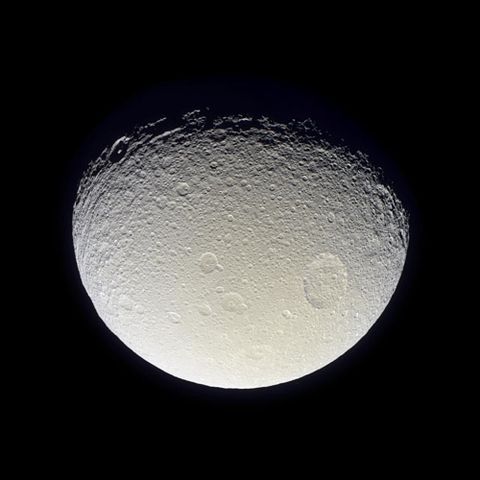Tethys, a moon of Saturn, imaged by the Cassini-Huygens Mission. The canyons of Ithaca Chasma can just be made out at the top left of the image.
| Public domainPublic domainfalsefalse |
 |
This file is in the public domain because it was solely created by NASA. NASA copyright policy states that "NASA material is not protected by copyright unless noted". (See Template:PD-USGov, NASA copyright policy page or JPL Image Use Policy.) |
|
|
|
Warnings:
- Use of NASA logos, insignia and emblems are restricted per US law 14 CFR 1221.
- The NASA website hosts a large number of images from the Soviet/ Russian space agency, and other non-American space agencies. These are not necessarily in the public domain.
- Materials based on Hubble Space Telescope data may be copyrighted if they are not explicitly produced by the STScI. See also {{ PD-Hubble}} and {{ Cc-Hubble}}.
- The SOHO (ESA & NASA) joint project implies that all materials created by its probe are copyrighted and require permission for commercial non-educational use.
- Images featured on the Astronomy Picture of the Day (APOD) web site may be copyrighted.
|
Link to the external image:
http://photojournal.jpl.nasa.gov/catalog/PIA06140
Original caption released with the image:
Having passed closer to Tethys than the Voyager 2 spacecraft, Cassini has returned the best-ever natural colour view of this icy Saturnian moon.
As seen here, the battered surface of Tethys (1,060 kilometers, or 659 miles across) has a neutral hue. The image here is a mosaic of two footprints. Three images taken in the red, green and blue filters were taken to form a natural colour composite. The result reveals a world nearly saturated with craters - many small craters lie on top of older, larger ones, suggesting an ancient surface. At the top and along the boundary between day and night, the moon's terrain has a grooved appearance.
This moon is known to have a density very close to that of water, indicating it is likely composed mainly of water ice. Its frozen mysteries await Cassini's planned close flyby in September 2005.
The view shows primarily the trailing hemisphere of Tethys, which is the side opposite the moon's direction of motion in its orbit. The image has been rotated so that north on Tethys is up.
The images comprising this colour view were taken with the Cassini spacecraft narrow angle camera on Oct. 28, 2004, at a distance of about 256,000 kilometers (159,000 miles) from Tethys and at a Sun-Tethys-spacecraft, or phase, angle of 50 degrees. The image scale is 1.5 kilometers (0.9 miles) per pixel.
The Cassini-Huygens mission is a cooperative project of NASA, the European Space Agency and the Italian Space Agency. The Jet Propulsion Laboratory, a division of the California Institute of Technology in Pasadena, manages the Cassini-Huygens mission for NASA's Science Mission Directorate, Washington, D.C. The Cassini orbiter and its two onboard cameras were designed, developed and assembled at JPL. The imaging team is based at the Space Science Institute, Boulder, Colo.
For more information about the Cassini-Huygens mission, visit http://saturn.jpl.nasa.gov and the Cassini imaging team home page, http://ciclops.org .
Image Credit: NASA/JPL/Space Science Institute
The following pages on Schools Wikipedia link to this image (list may be incomplete):





